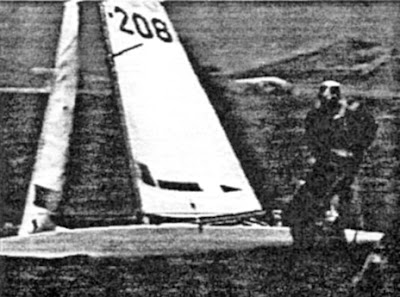Photo by Robert Müller, of two old-rule Nethercott IC's racing the previous IC World Championship in Germany. Photo was lifted from the World International Canoe website.
I had a debrief phone call from Earwigoagin's 2014 IC Worlds correspondent, Fran De Faymoreau and he offered these conclusions from the just completed World Championship at Richmond YC, San Francisco.
- The Chris Maas wedge design is clearly superior in anything over very light conditions. The top two were Chris Maas designs with Mikey winning in a slightly older model with slightly fuller forward sections. The Germans have developed a Chris Maas variant in which Peter Ullman fashioned a late regatta surge into a fourth overall.
- The Clark clan, father Steve, sons, Dave and Willie, were sailing plywood wedges. They were fast but prone to suffering breakages. They were also slightly heavy, around 5kg over weight.
Some of my own observations from very far away.
- It looks like Colin Brown (GBR) won the over-60 award, finishing in 12th place. An absolutely amazing feat given the very tough conditions. (This is an educated guess and someone may have to correct me on this.)
- Tweezerman has always liked the idea of a Persistence trophy, particularly in heavy-air regattas so Earwigoagin would like to recognize John Gilmour (USA) of Richmond Y.C who finished every race to place 20th overall. TOH to John and Tweezerman promises to supply you with a craft beer whenever we cross paths.
- Tweezerman was also very surprised to see a suit of IC sails of his design and manufacture that were used in the 1993 Worlds (under the Shore Sails label) split between two Nethercotts (one had the mainsail, the other had the jib). Obviously these sails were well beyond the use-before date but still heart warming to see your own fabric creation kicking around twenty years later.













